
A digital single-lens reflex camera is a digital camera that combines the optics and mechanisms of a single-lens reflex camera with a solid-state image sensor and digitally records the images from the sensor.

Sigma Corporation is a Japanese company, manufacturing cameras, lenses, flashes and other photographic accessories. All Sigma products are produced in the company's own Aizu factory in Bandai, Fukushima, Japan. Although Sigma produces several camera models, the company is best known for producing high-quality lenses and other accessories that are compatible with the cameras produced by other companies.

The Canon PowerShot G is a series of digital cameras introduced by Canon in its PowerShot line in 2000. The G series cameras are Canon's flagship compact models aimed at photography enthusiasts desiring more flexibility than a typical point-and-shoot without the bulk of a digital single-lens reflex camera.

Advanced Photo System type-C (APS-C) is an image sensor format approximately equivalent in size to the Advanced Photo System film negative in its C ("Classic") format, of 25.1×16.7 mm, an aspect ratio of 3:2 and Ø 30.15 mm field diameter. It is therefore also equivalent in size to the Super 35 motion picture film format, which has the dimensions of 24.89 mm × 18.66 mm and Ø 31.11 mm field diameter.
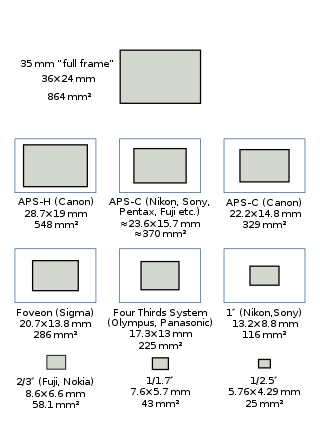
A full-frame DSLR is a digital single-lens reflex camera (DSLR) with a 35 mm image sensor format. Historically, 35 mm was one of the standard film formats, alongside larger ones, such as medium format and large format. The full-frame DSLR is in contrast to full-frame mirrorless interchangeable-lens cameras, and DSLR and mirrorless cameras with smaller sensors, much smaller than a full 35 mm frame. Many digital cameras, both compact and SLR models, use a smaller-than-35 mm frame as it is easier and cheaper to manufacture imaging sensors at a smaller size. Historically, the earliest digital SLR models, such as the Nikon NASA F4 or Kodak DCS 100, also used a smaller sensor.

The Leica M mount is a camera lens mount introduced in 1954 with the Leica M3, and a range of lenses. It has been used on all the Leica M-series cameras and certain accessories up to the current film Leica M-A and digital Leica M11 cameras.

The Ricoh GR Digital II is a compact digital camera, the successor of the Ricoh GR Digital and one of a series of Ricoh GR digital cameras.

In photography, the 35 mm equivalent focal length is a measure of the angle of view for a particular combination of a camera lens and film or image sensor size. The term is popular because in the early years of digital photography, most photographers experienced with interchangeable lenses were most familiar with the 35 mm film format.

The Micro Four Thirds system is a standard released by Olympus and Panasonic in 2008, for the design and development of mirrorless interchangeable lens digital cameras, camcorders and lenses. Camera bodies are available from Blackmagic, DJI, JVC, Kodak, Olympus, Panasonic, Sharp, and Xiaomi. MFT lenses are produced by Cosina Voigtländer, Kowa, Kodak, Mitakon, Olympus, Panasonic, Samyang, Sharp, Sigma, SLR Magic, Tamron, Tokina, TTArtisan, Veydra, Xiaomi, Laowa, Yongnuo, Zonlai, Lensbaby, Venus Optics and 7artisans amongst others.
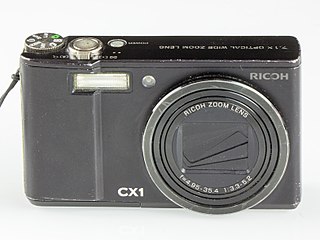
The Ricoh CX1 has been introduced by Ricoh in 2009. This is the first Ricoh camera to use a CMOS sensor. It allows it to operate at four frames/sec and perform hi-speed continuous shooting.

Leica X1 is a compact fixed-lens, large-sensor digital camera by Leica. The pre-production model was released to reviewers in September 2009.

The Ricoh GR was a series of point-and-shoot, or compact, 35 mm film cameras made by Ricoh and introduced between 1996 and 2001. Specific camera models include the GR1, GR10, GR1s, GR1v, and GR21. The GR name was later used for Ricoh's GR series of digital cameras, which began production in 2005.
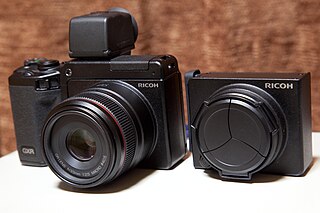
The Ricoh GXR is a compact digital camera first announced by Ricoh Company, Ltd, Tokyo on November 10, 2009. Unlike conventional cameras which either have a fixed lens and sensor or interchangeable lens and a fixed sensor, the GXR takes interchangeable units, each housing a lens, sensor and image processing engine, sometimes called a "lensor" as a portmanteau of lens and sensor.

A mirrorless camera is a digital camera which, in contrast to DSLRs, does not use a mirror in order to ensure that the image presented to the photographer through the viewfinder is identical to that taken by the camera. They have come to replace DSLRs, which have historically dominated interchangeable lens cameras. Other terms include electronic viewfinder interchangeable lens (EVIL) cameras and compact system cameras (CSCs).
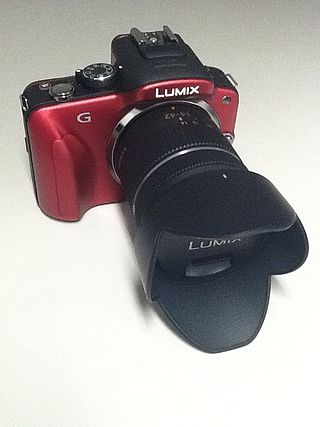
The Panasonic Lumix DMC-G3 is a digital mirrorless interchangeable lens camera adhering to the joint Olympus and Panasonic Micro Four Thirds System (MFT) system design standard. The Panasonic Lumix DMC-G3 is the eighth Panasonic MFT camera introduced under the standard and the thirteenth model MFT camera introduced by either Olympus or Panasonic, as of the G3 product announcement date.
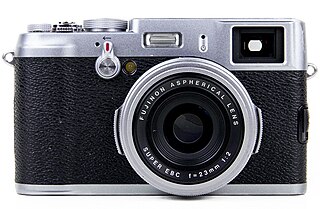
The Fujifilm X100 is a series of digital compact cameras with a fixed prime lens. Originally part of the FinePix line, then becoming a member of the X series from Fujifilm, the X100 series includes the FinePix X100, X100S, X100T, X100F, X100V, and X100VI. They each have a large image sensor and a 23 mm lens. All six cameras have received generally positive reviews.
The Sony Cyber-shot DSC-RX100 series is a high-end compact camera part of the wider Sony RX series. It started with the DSC-RX100, announced on 6 June 2012, and is part of the Cyber-shot RX line of digital cameras made by Sony. Seven annual generations have been released so far until 2019, all equipped with a one-inch 20-Megapixel image sensor and rotary knob around the lens. Filming at up to 1080p at 60fps is supported by the first three generations, the third additionally with 720p at 120fps, and up to 2160p (4K) at 30fps and 1080p at 120fps high frame rate video since the fourth.

The Sony α7, α7R, α7S and α7C are four closely related families of full-frame mirrorless interchangeable-lens cameras. The first two were announced in October 2013, the third in April 2014 and the fourth in September 2020. They are Sony's first full-frame mirrorless interchangeable lens cameras and share the E-mount with the company's smaller sensor NEX series.

The Ricoh GR is a digital large sensor compact camera announced by Ricoh on April 17, 2013, one of a number of Ricoh GR digital cameras. It was succeeded by the Ricoh GR II in 2015 and the Ricoh GR III in 2019.
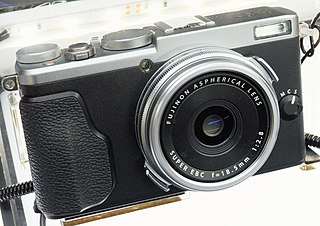
The Fujifilm X70 is an APS-C sensor digital compact camera with an 18.5 mm fixed prime lens. It is part of Fujifilm's X-Series of cameras. It was announced in January 2016 and was released on 18 February 2016.





























